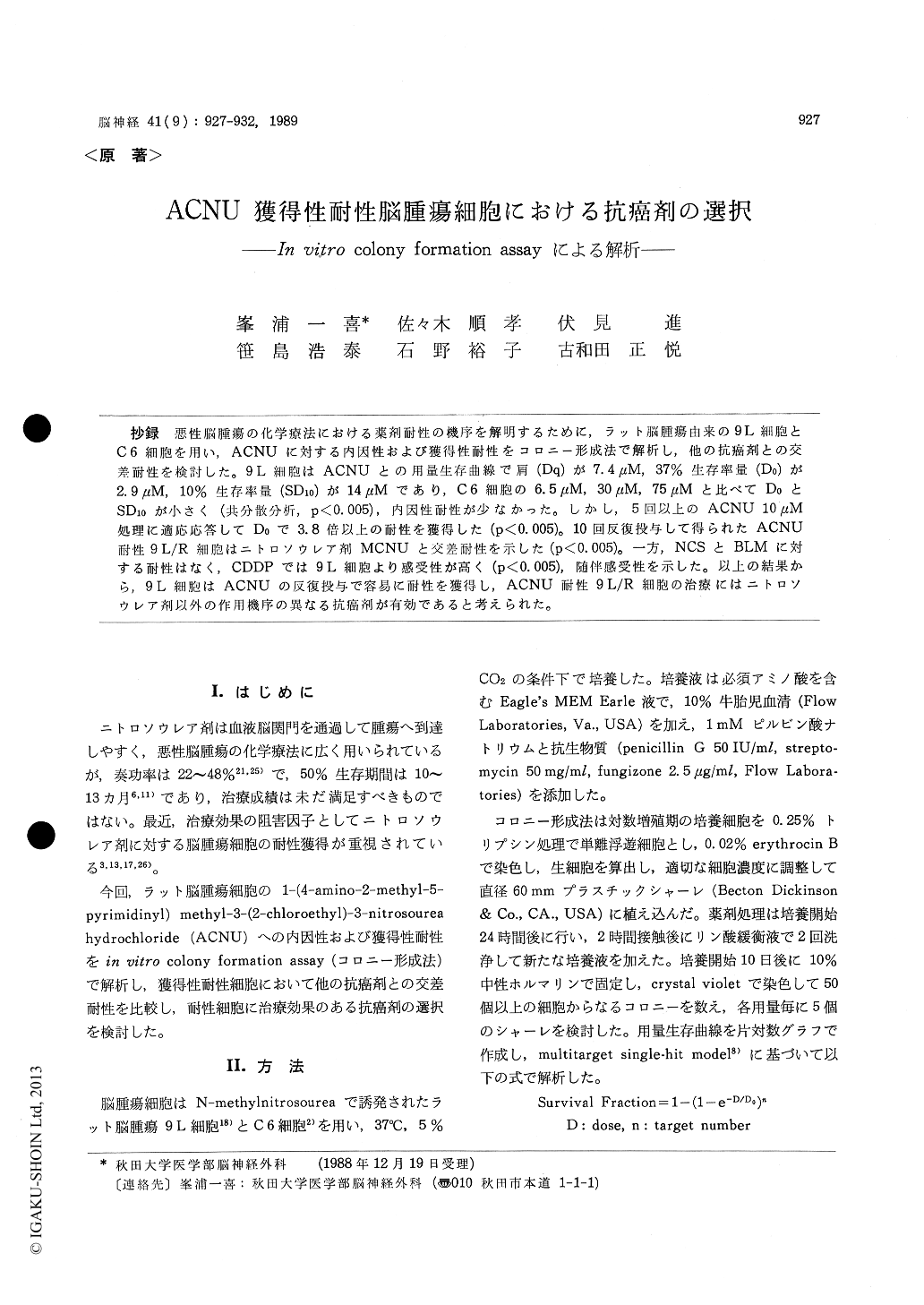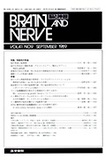Japanese
English
- 有料閲覧
- Abstract 文献概要
- 1ページ目 Look Inside
抄録 悪性脳腫瘍の化学療法における薬剤耐性の機序を解明するために,ラット脳腫瘍由来の9L細胞とC6細胞を用い,ACNUに対する内因性および獲得性耐性をコロニー形成法で解析し,他の抗癌剤との交差耐性を検討した。9L細胞はACNUとの用量生存曲線で肩(Dq)が7.4μM,37%生存率量(D0)が2.9μM,10%生存率量(SD10)が14μMであり,C6細胞の6.5μM,30μM,75μMと比べてD0とSD10が小さく(共分散分析,p<0.005),内因性耐性が少なかった。しかし,5回以上のACNU10μM処理に適応応答してD0で3.8倍以上の耐性を獲得した(p<0.005)。10回反復投与して得られたACNU耐性9L/R細胞はニトロソウレア剤MCNUと交差耐性を示した(P<0.005)。一方,NCSとBLMに対する耐性はなく,CDDPでは9L細胞より感受性が高く(p<0.005),随伴感受性を示した。以上の結果から,9L細胞はACNUの反復投与で容易に耐性を獲得し,ACNU耐性9L/R細胞の治療にはニトロソゥレア剤以外の作用機序の異なる抗癌剤が有効であると考えられた。
Nitrosourea compounds have been widely used in the chemotherapy of malignant brain tumors, because of their blood-brain barrier permeability. However, drug resistance to nitrosoureas has beenrecently a major concern. Using an in vitro colony formation assay, intrinsic and acquired resistances to an anticancer nitrosourea, 1-(4-ami-no-2-methyl-5-pyrimidinyl) methyl-3-(2-chloro-ethyl)-3-nitrosourea hydrochloride (ACNU), were analyzed in rat 9 L and C 6 glioma cells. 9 L and C 6 cells were treated with varying doses of ACNU for 2 hours. Ten days after, the cells were fixed and stained with crystal violet. Colonies consisting more than 50 cells were counted. The survival fraction following treatment is the ratios of colony efficiency of treated cells to the colony efficiency of untreated control cells. The dose-response curve for ACNU indicated the existence of a shoulder (Dq, quasithreshold dose) at doses and an exponential cell-killing at higher doses with Do(37% survival dose). Based on dose-response curves correponding to multitarget single-hit mo-del, 9 L cells showed 7.4 μM, 2.9 μM, and 14 μM at Dq, D0, and SD10 (10% survival dose) values, respectively, whereas C 6 cells showed respective values of 6.4 μM, 30 μM, and 75 μM. 9 L cells had significantly less intrinsic resistance to ACNU than C6 cells at the p<0.005 level by a covari-ance analysis of the curves. As with changes of drug susceptibility after ACNU treatment, both parent cells were treated every other day (1, 5, and 10 repeated times) with various doses up to approximately 1% survival dose of the parent cells. 9 L cells acquired resistance by 5 and more times of 10 μM ACNU treatments. The degree of resistance to ACNU showed D0 values with more than 3.8 times that of the parent cells (p< 0.005), but no appreciable increases in resistance was observed with C6 cells. Subsequently, we tested cross-resistance to other antitumor drugs in clinical use in ACNU-resistant (9 L/R) cells, which had been established after 10 repeated treatments with a dose of 10,μM ACNU. The 9 L/R cells were reacted with methyl-6-[3-(2-chloroethyl)-3-nitrosoureido]-6-deoxy-a-D-glucopyranoside (MC-NU), bleomycin (BLM), neocarzinostatin (NCS), and cis-diamminedichloroplatinum(II)(CDDP). The 9 L/R cells showed complete cross-resistance to MCNU (p<0.005). In contrast, BLM and CDDP were still similarly cytotoxic, and NCS revealed rather higher susceptibility (p<0.005) to 9 L/R cells than to 9 L parent cells, indicative of a col-lateral sensitivity. Therefore, MCNU is disad-vantageous in the chemotherapy of the 9 L/R cells, probably because MCNU structurally belongs to the same class of alkylating agents as ACNU. Drugs other than nitrosoureas such as ACNU and MCNU should be used when the cell-killing effects in ACNU-resistant cells are to be obtained.

Copyright © 1989, Igaku-Shoin Ltd. All rights reserved.


